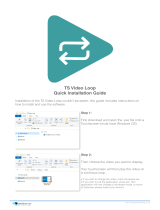Barco | weConnect admin guide
P 3 / 89
Introduction
These articles explain how to use the weConnect Administration interface to set up, control and
monitor a weConnect institute. You will learn how to manage users, configure locations and
classrooms, manage how users log in with or without Single Sign-On (SSO) integration and how to
monitor devices.
The articles were primarily written as a guide to set up an institute according to the best practices
we have collected. We highly recommend following the weConnect training provided by Barco
University to become an expert in weConnect before starting a completely new setup.
Setting up a new institute can be started as soon as you have received access to the administration
interface and does not require to wait for hardware deliveries. In contrast, the fastest way to
configure the system is to perform the first steps as soon as possible. Each step has one or more
dedicated articles.
The typical flow of an install will be to start with setting up the authentication methods. We provide
a separate integration document explaining how to integrate SSO within your institute.
At this point, you will want to set up user groups and maybe create special user accounts for cloud
administration use.
Next, we propose to configure the locations in the system. Locations represent the physical layout
of the institute. Users will come into contact with this. The naming as such should be
comprehensible for teachers and students.
These first steps can be done before any equipment has been delivered. After these steps, we
suggest focusing on making the IT department aware and ready to receive the display nodes on
the network. Please consult the network design article as a guide for this step. [KB7953]
Now is also the moment to make sure that (HA) proxy servers have been set up to ensure a smooth
integration of the hardware into the system.
Once the display nodes have arrived, the device configuration can take place.
The peripheral configuration is ideally the next step to make sure that the basic physical install can
be completed.
Finally, room configuration allows you to set the behavior of the rooms so that the system will
function as intended.
Important note: Some items in these menus are dependent on options that enabled or disabled for
your specific institute and may be missing for you.
System introduction and background information - [KB7709]
weConnect runs on Amazon Web Services. There are several clouds, all fully redundant and 24/7
monitored and managed by the Barco DevOps team.
The weConnect system is a multi-tenant cloud application. This means that the application
serves multiple customers. Each institute is a tenant, separated by others through separate
URLs. As such, each customer gets a unique link to use weConnect.
We run 2 clouds that customers can get access to:
Production: https://edu.barco.com/
User Acceptance Test (UAT): https://uat.edu.barco.com/






















